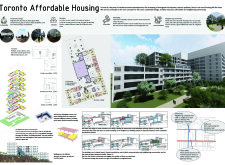5 key facts about this project
The design located in Toronto aims to meet the urgent need for affordable housing as the city's population continues to grow, particularly among immigrants. It focuses on creating adaptable living spaces through a flexible modular layout while incorporating sustainable principles to improve the neighborhood's environment. Beyond serving as a shelter, the building intends to foster a sense of community and shared purpose among its residents.
Sustainable Design
The building emphasizes sustainability with its use of greenery throughout the surroundings. This approach not only beautifies the urban landscape but also supports local wildlife, helping to create a more balanced ecosystem. Low-emissivity glass is incorporated into the façade to limit heat loss and reduce energy use. Such design choices reflect a strong commitment to minimizing the building's impact on the environment.
Modular Structure
With a modular design, the structure allows for a variety of living arrangements. This kind of flexibility ensures different configurations can meet the specific needs of future residents. The interior is planned to enhance practicality. Sliding wood doors can transform spaces, making it easy for residents to adapt their homes according to their changing lifestyles or preferences.
Community Interaction
The design places great importance on encouraging community interaction. Open spaces and public classrooms on the first floor act as gathering spots, giving residents a chance to connect with one another. This focus on social interaction is essential, especially given the nearby social housing. The layout aims to strengthen bonds within the community while ensuring everyone feels welcome.
Design Configuration
The building's L-shaped form is carefully designed to serve multiple purposes. It prevents blockage of views and pathways that connect residential and commercial areas. Staggered volumes create an inviting entrance, improving the experience for pedestrians. This thoughtful design detail not only establishes clear boundaries but also encourages movement and interaction, enhancing the overall neighborhood dynamic.



















































